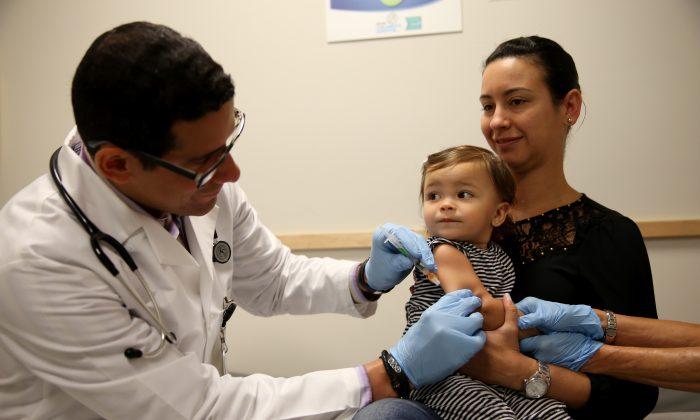The Centers for Disease Control (CDC) warns that the U.S. is seeing a “record number of measles cases.” There have been 592 confirmed cases of measles in 21 states reported to the CDC through the end of August.
It is the highest number of cases since measles elimination started being documented in the U.S. in 2000, according to the CDC. In the past 13 years, reported measles cases have only gone over 200 once. Most of those who have become infected with measles are not vaccinated.
Measles, also known as rubeola, is a highly contagious respiratory disease that can cause fever, a runny nose, a cough, and a rash all over the body. About ten percent of children who get measles also get ear infections, and about 5 percent get pneumonia. The death rate for children who get measles is about one in every 1,000
Adults who aren’t vaccinated can also contract measles, but children are more likely to have complications. Roseola (roseola infantum) and rubella (German measles) are also rash-causing diseases that often get confused with measles.
Be Careful
The CDC is particularly warning U.S. residents traveling overseas to be careful and to have up to date vaccinations before traveling. In certain parts of Europe, Africa, Asia, and the Pacific, measles is still a common illness and can be brought back to the U.S. by those traveling abroad.
One country considered to be high-risk is the Philippines, which has been going through a ongoing and large measles outbreak. The CDC believes that many of the U.S. cases have been brought into the country from the Philippines.
Last year, there were 11 instances of what the CDC qualifies as outbreaks. In 2014, there have been 18 outbreaks. An outbreak is typically characterized as a cluster of cases that spring up in one locale. In 2011, the World Health Organization reported that over 30 countries in Europe had a reported increase in measles, particularly in France.
Started in 1657
Measles first appeared in the U.S. in Boston in 1657. It wasn’t until 1971 that a vaccine was introduced, and by 2000 endemic measles was eliminated from the U.S.
At least one part of the U.S. is recovering from an outbreak. Ohio health officials said this week that an outbreak among the Amish in Knox County, who had traveled to the Philippines, is now under control. According to local channel 3 WKYC, Ohio had 377 cases of measles between March and July in nine counties. Nine people landed in the hospital with the illness.
The end of such an outbreak is measured 42 days after the onset of the most recent case. The window is based on two, 21-day incubation periods. Ohio passed that mark because the most recent onset date was July 23.
“In a virus in a disease like this, it could appear anytime, so we’re not looking to say it’s over over,” Ohio Department of Health spokeswoman Melanie Amato said. “We’re just saying the incubation period has passed, so it’s a great sign that measles has moved on.”
The Associated Press contributed to this report.




